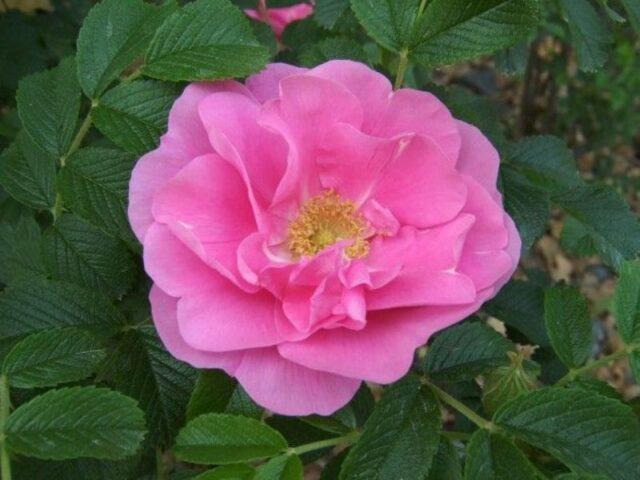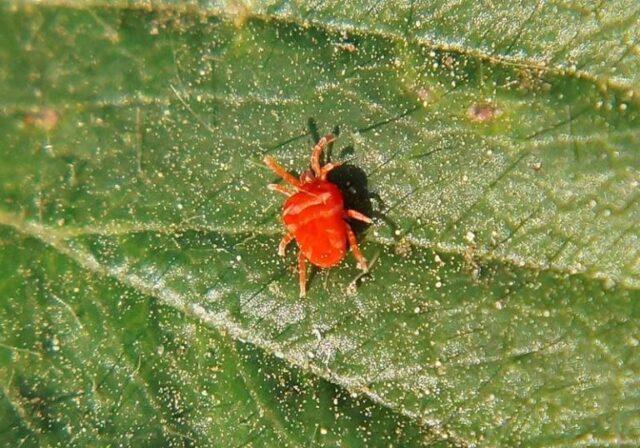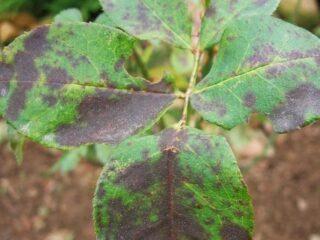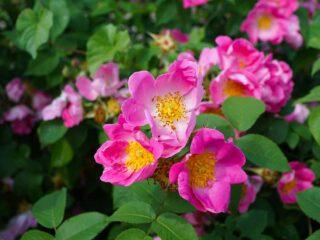Content
- 1 Botanical description of rugose hips
- 2 Where does the wrinkled rose hip grow?
- 3 Varieties of wrinkled rosehip
- 4 Chemical composition and benefits of rugose hips
- 5 Medical uses of rosehip rugosa
- 6 Features of planting and caring for wrinkled rose hips
- 7 Reproduction of wrinkled rosehip
- 8 Collection and preparation
- 9 Possible harm from rugose hips
- 10 Conclusion
Rosehip wrinkled is a beautiful plant, represented by many varieties. Before planting on a site, you need to study its features and requirements.
Botanical description of rugose hips
Wrinkled rose hips, or rugosa rose (Rosa rugosa) is a perennial shrub from the Rosaceae family. It has straight, thick shoots and often forms dense thickets.Old branches are woody and brown, and young flowering branches are green, with pubescence and abundant thorns. The leaves are arranged in an alternate order on the petioles, have an oval-elongated or elongated elliptical shape, and are jagged along the edges. The photo of a wrinkled rose hip shows that the plates have a relief surface.

On average, wrinkled rosehip grows up to 2.5 m in height
In June and July, the plant bears single or double-type buds collected in compact inflorescences. The shade, depending on the variety, can be white, red, pink or yellow. With good care and in a favorable climate, it blooms again in September or October. By autumn it produces fruits - fleshy, red or bright orange, flattened-spherical.
Is rugosa rosehip edible or not?
Wrinkled rosehip berries are suitable for consumption. They contain a large amount of vitamins, and many varieties have a pleasant taste. Teas and compotes, jams and jams, and marmalade are prepared based on the fruits.
Where does the wrinkled rose hip grow?
In its natural form, the culture is widespread in Japan, China and Korea, as well as in the Far East in Russia. Rosa rugosa is naturalized in Europe and North America, Australia and New Zealand. Prefers coastal regions, tolerates clay soils and loams, as well as sandstones.
Varieties of wrinkled rosehip
Wrinkled rosehip is especially popular as an ornamental plant. Based on it, many hybrid varieties with spectacular flowering have been bred.
Conrad Ferdinand Meyer
The hybrid variety Konrad Ferdinand Meyer rises up to 2.5 m above the ground and spreads 1.5 m wide.The shoots of the wrinkled rosehip are of a climbing type; the flowers are large, pink, with petals bent at the edges. During the decorative period it emits a rich sweet aroma; the leaves of the bush are light green.

Conrad Ferdinand Meyer is susceptible to rust and powdery mildew and requires careful care
Moje Hammarberg
The compact rugosa rose rises only 50 cm above the ground. It has large wrinkled leaves of a bright green hue and bears pink-violet flowers up to 9 cm in diameter. Characterized by high cold resistance.

Rose rugosa Moe Hammerberg emits a strong aroma
Grootendorst
Hybrid wrinkled rosehip is distinguished by very abundant flowering - large crimson-red brushes form on the shoots. Each consists of an average of ten buds, and their structure resembles a carnation due to the heavily jagged edge. The flowers are small in size, only 3-4 cm.

Rosehip Grootendorst grows up to 1.5 m
Rugelda
Varietal wrinkled rosehip grows up to 1.7 m, has thick prickly shoots and is rarely affected by diseases and insects. At the beginning of summer, reddish buds form on the branches, which subsequently open into yellow, double-type flowers.

Rosehip Rugelda blooms in clusters of 5-20 individual flowers
Kaiserin des Nordens
Wrinkled rose hips bloom in early summer and can remain decorative until late autumn. It bears large, up to 12 cm in diameter, double flowers of a wine-red hue. Emits a strong aroma and produces healthy edible fruits.

An adult Kaiserin des Nordens bush can have about fifty flowers
Rubra
A variety of wrinkled rose hips up to 2.5 m in height blooms with large pink-crimson buds from June to September. Since August it bears bright red spherical fruits up to 2.5 cm in diameter. It is characterized by high frost resistance and drought tolerance.

Rosa Rugosa Rubra can bloom again in autumn
Alba
A hybrid variety up to 2 m above ground level blooms in mid-summer and remains decorative for a month. The inflorescences of wrinkled rose hips are light pink or white, up to 8 cm wide, and look very beautiful against the backdrop of bright greenery.

Rosa rugosa alba does not bear fruit
Pink noz Klauds
Bright pink wrinkled rosehip blooms with beautiful semi-double flowers with a spicy strong aroma. As they wither, the buds turn pale and acquire a creamy color. The decorative period begins at the end of June, the flowers are collected in brushes.

Rosehip Pink Nose Clouds can tolerate frosts down to - 40 ° C
Hansa
One of the most popular wrinkled varieties, up to 2 m high, is distinguished by double red-lilac flowers. It blooms in early summer and remains decorative until late autumn, forms dense thickets and is often used for hedges.

Hansa's wrinkled rosehip bears large vitamin fruits
Charles Albanel
A hybrid of wrinkled rosehip with double pink flowers blooms in June. The buds on the shoots of the plant are collected in clusters of 3-7 pieces. The variety grows well in width and rarely suffers from pests and diseases. Fruits with large round berries.

Rosehip Charles Albanel is suitable for growing in cold regions
Jens Munk
The frost-resistant hybrid of wrinkled rose hips blooms in waves throughout the summer and until late autumn. Cupped pink buds look beautiful against the background of embossed bright green leaves. The species is resistant to major diseases and lends itself well to vegetative propagation.

Rosa Rugosa Jenz Munch grows up to 1.2 m
Chemical composition and benefits of rugose hips
Wrinkled rosehip is in demand among gardeners not only because of its beautiful flowering. The fruits and green parts of the plant contain a large amount of valuable substances. They contain:
- B vitamins;
- ascorbic acid;
- potassium, magnesium and fluorine;
- vitamins K and PP;
- citric and malic acids;
- pectins;
- manganese, copper and zinc;
- chrome and iron;
- calcium;
- tannins;
- tocopherol;
- cellulose.
Due to its rich composition, rugosa rose is widely used in folk recipes.
Medical uses of rosehip rugosa
For treatment, not only the fruits of the wrinkled rose hips are used, but also its leaves, flowers, young shoots and roots. Rose rugosa has a pronounced beneficial effect on the body. Namely:
- stops diarrhea due to strong astringent properties;
- helps fight inflammation and colds;
- has a mild analgesic effect;
- relieves vascular spasms and helps with migraines;
- lowers blood pressure and is beneficial for hypertension;
- removes excess fluids from the body, eliminates swelling and improves kidney function;
- eliminates bacterial processes in the throat and oral cavity;
- promotes gum healing during periodontal disease;
- stimulates the immune system and strengthens the body against viruses and infections in the autumn;
- improves blood counts and restores strength after long illnesses and operations.
Wrinkled rosehip is used to speed up digestive processes and for the prevention of cancer. Products based on the plant have a beneficial effect on the condition of the hair, help get rid of acne and blackheads on the skin, and have a rejuvenating effect.
Features of planting and caring for wrinkled rose hips
Rugosa park rose, or wrinkled rose hips, does not have particularly strict requirements for growing conditions. To successfully plant shrubs on your site, you only need to know the basic rules.
Requirements for planting site and soil
Wrinkled rosehip prefers well-lit areas of the garden. It is best to place the bush on the south side on a slight hill. The root system of wrinkled rosehip lies quite deep, so it needs to be planted far from groundwater. The soil should be saturated with humus; loams and sandy loams with a neutral acidity level are optimal for the plant.
How to plant correctly
Before planting in the selected area for the wrinkled rosehip shrub, prepare the soil:
- The soil is dug up and fertilized with organic matter and minerals - 1 m2 it is necessary to add 10 kg of peat or humus, 50 g of potassium salt and 10 g of superphosphate.
- Half fill a planting hole about 50x50 cm with prepared mixed soil, and also add a little peat and coarse sand.
- The seedlings are pre-soaked in water and clay mash, after which they are immersed in a hole, deepening the root collar to 8 cm, and covered with the remaining soil.
Immediately after planting, wrinkled rose hips require abundant watering and mulching. When planting several shrubs at once, leave gaps of 1.5 m between them.

For quick engraftment, it is better to cut the aerial part of the rose hips to 1/3 of the length of the shoots
When and what to fertilize
In the first two years after planting on the site, wrinkled rose hips do not need feeding. In the third season, it can be fertilized with nitrogen - usually urea is added at the rate of 20 g per 1 m2.
After entering the fruiting period, the bush begins to be fed with potassium and phosphorus. In autumn, 50 g of superphosphate and 20 g of potassium salt are added to the soil.
Disease and pest control
The rugosa rose is resistant to diseases and pests, but can suffer from some ailments if not properly cared for. Among the fungi that are dangerous for crops are:
- rust - orange spots that look like pads appear on the leaves and young stems;
Rust of wrinkled studs especially often develops when overmoistened.
- powdery mildew - a dry whitish coating appears on the leaves;
Under the influence of powdery mildew, the photosynthesis processes of wrinkled rose hips are disrupted
- black spot - the leaves of the plant are covered with dark, uneven marks;
As black spot develops, the marks turn into necrotic areas and holes
Treatment of wrinkled rosehip diseases is carried out with Bordeaux mixture, copper sulfate and the drug Fundazol. Spraying is carried out several times a season at intervals of 2-3 weeks, all affected shoots are pre-cut.
The most commonly seen pests on wrinkled rose hips are:
- spider mite - the insect entangles shoots with a thin web and usually appears during a period of drought;
A good prevention of spider mites is regular spraying of the crown.
- leaf roller - under the influence of the insect, the plates of the wrinkled rose hips are deformed and curled;
The danger to rose hips is not the leaf roller butterfly itself, but its caterpillars
- roseate sawfly - the insect attacks leaves and young shoots, weakens the crop and interferes with its development.
The sawfly lays eggs under the bark of young rosehip shoots
In pest control for wrinkled rose hips, insecticidal and acaricidal preparations are used - Karbofos, Rogor, Actellik and others. You can also treat shrubs with a soap solution and kerosene diluted with plenty of water. Spraying is carried out 3-4 times per season from early spring until the beginning of fruit set.
Preparing for winter
Rose rugosa has good frost resistance. Most varieties do not require careful shelter for the winter. However, it is still necessary to take care of insulating the roots - shortly before the cold weather, the tree trunk circle of the bush is generously mulched with humus or peat and covered with dry straw. It is recommended to cover the crown of wrinkled rose hips with lutrasil or burlap for up to three years.
Reproduction of wrinkled rosehip
On the site, wrinkled rose hips are propagated in three main ways:
- Green cuttings. At the end of June or beginning of July, shoots about 10-15 cm long with three nodes are cut from an adult bush. The lower cut is made at an acute angle, the cutting is placed in a solution of a growth stimulator for a day. After this, the shoot can be immediately rooted in the ground - before autumn it will take root on the site.
Green cuttings are first planted in a school and transferred to a permanent place after a year
- Root shoots. Wrinkled rose hips produce abundant daughter shoots in the lower part, which can be used for propagation. A healthy shoot about 40 cm long is dug out along with part of the root and immediately planted in a new place.
Rosehip shoots can also be hilled up until their own roots form and separated after a year
- Dividing the bush. If an adult rugosa rose has grown greatly, you can use a sharp shovel to cut it into several parts along the rhizome. The sections are sprinkled with ash or crushed coal and, according to the standard algorithm, the sections are planted in separate holes.
- It is recommended to propagate by division bushes at the age of 5-6 years
It is recommended to propagate by division bushes at the age of 5-6 years
Collection and preparation
For medicinal purposes, you can collect any parts of the wrinkled rose hips. The fruits are of the greatest value; they are harvested as they ripen, from August to the end of October. You need to pick bright red, but dense berries from the branches, without waiting until they begin to darken and soften.The fruits are consumed fresh, used for making compotes and jams, and also dried - both in air and in an oven or dryer at a temperature of about 60 ° C.
The buds and leaves of wrinkled rose hips are collected during the flowering period of the crop. For medicinal use, they also need to be dried under a canopy or in an oven. But in the latter case, the temperature is set to only about 45 °C in order to preserve the maximum of valuable components in medicinal raw materials.
The roots of wrinkled rose hips must be dug up while the plant is dormant - in late autumn or early spring. The collected raw materials are washed to remove any remaining soil and dried, having previously been cut into pieces of 8-10 cm.
Any parts of the medicinal plant should be stored in low humidity and away from sunlight. It is best to put wrinkled rose hips in paper bags or linen bags and put them in a closet. The raw material retains its benefits for two years, and the roots of the rugosa rose can be used for treatment for three years.
Possible harm from rugose hips
The wrinkled rose hip Rosa rugosa can bring not only benefits, but also harm. The fruits of the plant and medicines based on it should not be consumed:
- for inflammatory diseases of the myocardium;
- for chronic hypotension;
- with exacerbation of peptic ulcer and pancreatitis;
- with an excess of vitamin C in the body;
- for individual allergies;
- with a tendency to thrombosis;
- for acute inflammation of the kidneys and urinary tract;
- with infectious jaundice and large stones in the gall bladder.
During pregnancy, wrinkled rose hips should be consumed with caution and with the permission of a doctor.When breastfeeding, it should be abandoned in the first three months; the plant can provoke allergies in the baby.

Rose hips in the form of compotes and decoctions can be offered to children from six months, but in small dosages
If consumed in excess, wrinkled rose hips can cause an overdose of vitamin C. Side effects can develop when using berries and plant-based drinks on an empty stomach, especially with increased stomach acidity. Rosehip negatively affects the condition of tooth enamel, so after decoctions and compotes it is advisable to rinse your mouth with clean water.
Conclusion
Rosehip wrinkled is a beautiful and very healthy plant. It is not difficult to plant it in your summer cottage. In the process of caring for the crop, you need to pay attention to periodic feeding and prevention of fungi and pests.








 It is recommended to propagate by division bushes at the age of 5-6 years
It is recommended to propagate by division bushes at the age of 5-6 years







